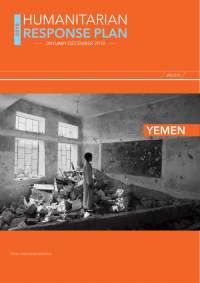Yemen: Humanitarian Response Plan January-December 2018
THE HUMANITARIAN RESPONSE PLAN AT A GLANCE
STRATEGIC OBJECTIVE 1
Provide life-saving assistance to the most vulnerable people in Yemen through an effective, targeted response
STRATEGIC OBJECTIVE 2
Ensure that all assistance promotes the protection, safety & dignity of affected people, and is provided equitably to men, women, boys and girls
STRATEGIC OBJECTIVE 3
Support and preserve services & institutions essential to immediate humanitarian action & promote access to resilient livelihood opportunities
STRATEGIC OBJECTIVE 4
Deliver a principled, multi-sectoral, coordinated and inclusive humanitarian response that is accountable to and advocates effectively for the most vulnerable people in Yemen with enhanced engagement of national partners
OVERVIEW OF THE CRISIS
Entering the third year of humanitarian crisis, conflict, severe economic decline, and collapsing essential public services have taken an enormous toll on the Yemeni population, exacerbating existing vulnerabilities.
Yemenis are facing multiple crises, including armed conflict, displacement, risk of famine and disease outbreaks that have created the worst man-made humanitarian crisis. Some 75 per cent of the population – 22.2 million people – are in need of humanitarian assistance, including 11.3 million people in acute need who urgently require immediate assistance to survive – an increase by one million since June 2017. Vulnerable populations in 107 out of 333 districts are facing heightened risk of famine and require integrated response efforts to avert a looming catastrophe.
This chapter briefly summarizes the overall impact of the crisis. More details and sector-specific needs analyses appear in the 2018 Yemen Humanitarian Needs Overview (HNO). The already dire humanitarian situation outlined in the 2018 HNO further deteriorated after its publication. During November and December 2017 hostilities escalated and the extended closure of Yemen’s ports for commercial imports resulted in a sharp increase in prices of basic commodities, accelerating food insecurity and the collapse of already fragile basic services. For this YHRP, partners have revisited their planning assumptions to ensure that this aggravation of the situation is reflected.
*One of the world’s largest protection crises
Escalating conflict continues to inflict civilian casualties and cause extensive damage to public and private infrastructure. Half of the Yemeni population live in areas directly affected by conflict, many of whom are suffering from the deliberate targeting of civilians and civilian infrastructure, and other apparent violations of International Humanitarian Law (IHL). As of late December 2017, health facilities reported 9,245 conflict related deaths and over 52,807 injuries – meaning that an average of 60 people have been killed or injured every day in the past two and a half years. Given that only 50 per cent of health facilities remain functional, and acknowledging the limited reporting capacity across the country, this number is significantly underreported. Over three million people have been forced to flee from their homes since the escalation of conflict two and a half years ago, including 2 million who remain displaced. The intensification of the conflict since November has resulted in alarming levels of civilian impact including high level of casualties and additional displacements.
Collapse of basic services and institutions
Essential basic services and the institutions that provide them are at the brink of total collapse. Conflict, economic decline and subsequent disruption of operational budgets and salary payments in public sector institutions have contributed to this collapse. In this situation, Yemen is increasingly becoming susceptible to disease outbreaks: crippled public health and WASH systems contributed to the unprecedented scale of the 2017 cholera outbreak, which is followed by a rapidly spreading suspected diphtheria outbreak attributed to low vaccination coverage. Only half of all health facilities are functioning, and even these face severe shortages in medicines, equipment, and staff. Similarly, some 16 million people lack adequate access to clean water, sanitation and hygiene, which is attributed to the physical damage to infrastructure, lack of resources (including fuel), and suspension of salaries. The deficit has also hampered agriculture extension and veterinary services with an estimated 90 per cent of animal health facilities either fully closed or functioning below their capacity due to non-payment of salaries and lack of operating budget. The system is increasingly depending on humanitarian aid stretching beyond its scope and remit to continue to provide minimum basic assistance, which cannot, however, compensate for collapsing systems.
Import Restrictions
Before the escalation of the crisis, Yemen imported 80-90 per cent of its staple foods and required an estimated 544,000 metric tons of imported fuel per month for transportation and powering water-systems and health facilities, among other activities. Even before the imposition of complete and partial closure of ports through the final months of 2017, fluctuating restrictions on imports, damaged port infrastructure, insurance and banking hurdles, security risks and high transport costs were key factors negatively affecting imports and distribution of critical goods across Yemen. Damaged port infrastructure has further undermined the ability to import key commodities including food, fuel, and medical supplies at the scale required. Al Hudaydah port, which accounts for 70-80 per cent of commercial imports in Yemen, remains a critical lifeline, despite operating at reduced capacity after being hit by an airstrike in August 2015. The extended blockade imposed on Al Hudaydah and Salif ports on 6 November 2017 significantly threatened this lifeline of Yemenis. In the aftermath of the closure of these supply routes, prices of basic commodities significantly increased, further accelerating food insecurity, loss of livelihoods and the collapse of basic facilities. The Saudi-led Coalition (SLC) announced a 30-day opening of Al Hudaydah and Salif ports to commercial imports on 20 December 2017, but only a sustained flow of imports of essential basic goods can avert further catastrophe.

